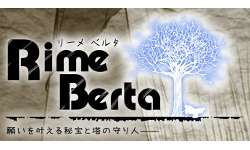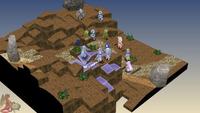|
|

|
PLATFORM
|
PC
|
BATTLE SYSTEM
|

|
INTERACTION
|

|
ORIGINALITY
|

|
STORY
|

|
MUSIC & SOUND
|

|
VISUALS
|

|
CHALLENGE
|
Moderate
|
COMPLETION TIME
|
Less than 20 Hours
|
|
OVERALL

|
+ Some interesting tactical ideas
+ A few good maps
- Lots of inscrutable setup rules
- Irritating interface
|
Click here for scoring definitions
|
|
|
Rime Berta is an example of the Japanese indie PC scene, developed by Next-Soft and given a localization for English speakers by Playism. The developer's goal was to make a tactical game that fits the recognizable template, and it offers some marginal enjoyment for a specific audience. Anyone not well versed in tactical games is unlikely to gain any enjoyment here, and the few things effectively done require wading through the rest.
A team of up to five player-controlled characters do battle with varying numbers of opponents by standard tactical rules. Characters march over tiles to grapple with each other, the player's turns elapse before the opposition takes its actions, and experience is gained from carrying out tasks. Where Rime Berta varies a bit is in granting every participant a pool of automatically-regenerating action points that govern what can be done, although only one manually selected technique is usable per turn. AP also dictates the use of skills, with no MP whatsoever and a certain number of uses simply granted per map. Characters eventually learn reaction skills that are dependent upon having some spare AP to use, and leaving someone inactive for a turn can help out greatly for disrupting the enemy onslaught with such skills as automatically stopping spells from being cast or shielding a teammate.
Character growth is handled interestingly here, with abilities becoming stronger through constant use. Where Rime Berta stumbles is in alerting players about its class change permutations, which are left blank until the conditions have been met. Since those conditions rely upon powering up certain abilities, knowing which ones are key would have been extremely useful. Many times new classes will be encountered when the player has no idea how to access them, which is bewildering.
New skills are learned through leveling, but must then be manually assigned by the player, with only six open slots for additional abilities. This is an effective means of forcing meaningful choices onto the player, but characters tend to learn a lot more than six abilities to take into battle. New techniques can include statistic buffs and reaction abilities along with manually directed actions in battle, which can make the limitation feel very restrictive. It also doesn't help when trying to figure out which abilities are necessary to unlock new class change options.
 Unnecessarily constrictive or a great customization opportunity? The choice is yours.
Unnecessarily constrictive or a great customization opportunity? The choice is yours.
|
|
A total of three characters with speaking roles join during Rime Berta, and the rest of the roster is filled when one of the defeated foes in a battle offers to join afterward. There is no way to pick which adversary makes the offer, and after some encounters no one feels like joining. With a total of five slots for battle the lineup will nevertheless quickly be filled, and Rime Berta has an option to fuse characters together. Fusion increases the statistics of the survivor, but not by a huge amount — even after multiple fusions the statistic effect is often still in the single digits. While a useful means of making otherwise redundant characters contribute, its potential is far from realized.
Rime Berta is controlled entirely with the mouse, and the multitude of functions this instrument must perform never feels right for the game. Selecting a character can be frustrating due to the steep isometric view, and when the game does not always recognize a click near the screen's periphery. Most of the rules governing what happens in the game require a look at the online manual, but even there the explanations may not suffice, ensuring that the whole time through is a learning experience of the undesired kind.
Difficulty can be changed between battles in Rime Berta, but even the easy setting can be nasty due to some maps. A few maps have interesting layouts with narrow pathways and interesting height considerations, which catch the eye amid the many uninteresting collections of tiles. For several encounters the game simply tosses the quintet of player characters into the middle of the enemy, and in most battles the opposition will immediately move toward the protagonists. Considering a concerted attack has the capability to destroy the player, this could be insurmountable if enemy AI didn't display foolishness much of the time. Foes are quite willing to use attacks that kill their allies if it damages one of the player's group, and will often forbear from their stronger techniques in favor of ineffectual maneuvers. The exception to this is the final battle, in which a concerted enemy assault will prove very hard to survive. At least defeat has no real consequence, since the game allows battles to be retried or abandoned while keeping all newly acquired character improvements.
 Technically, this is a game with 100% female characters, but don't get too excited about it.
Technically, this is a game with 100% female characters, but don't get too excited about it.
|
|
Story is not the focal point of Rime Berta, and its sparse occurrences are underwhelming. A girl named Livia is attempting to ascend the fabled tower which holds her world's Hallows, supposedly capable of granting any wish, which she will use to heal the illness afflicting her hometown. Along the way she finds that commanding the puppet inhabitants of the tower is possible, and since plenty of unruly adversaries are in her way, battles result. The fact that every character is female might have some subtext, but the little dialogue in the game is not interesting to read and the overall story commands no interest.
The visuals are workmanlike and get the job done, but not much more. For an indie release this is understandable, though the aggravating isometric perspective often obscures things that would be nice to see. Music is quite pleasant throughout, and sports a pretty good variety of tracks to prevent saturation by any one tune. These compositions are not too memorable after the game is finished though.
Rime Berta is something I would rather have played with controller support, because being forced to use the mouse constantly did not make me wish that option was immediately enabled for every other tactical game in existence. Several times I won because the AI did inexplicable things, and none of the battlefields or opponent rosters were memorable. This gets the job done for those who desperately need a new tactical experience and can't find anything else to play, but it's a hard recommendation to make even so.
Review Archives
|









